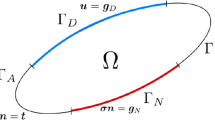Abstract
In this paper presents mathematical models for 2D and 3D problems of potential theory with consideration of anisotropy of the piecewise homogeneous medium. To find solutions of the respective problems of potential theory, indirect methods of boundary and near-boundary elements have been used. The orthotropy effect in homogeneous and piecewise-homogeneous half-spaces has been investigated. The effect of orthotropy in a medium without inclusions and with one inclusion is investigated. A software implementation of the proposed approach has been carried out.
Access this chapter
Tax calculation will be finalised at checkout
Purchases are for personal use only
Similar content being viewed by others
References
Pervago, E.V.: Influence of anisotropy and inhomogeneity on results of electrical sounding. Research Paper PhD Phys. & Math. sc., 83 p. MSU, Moscow (1998). (in Russian)
Bolshakov, D.K., Modin, I.N., Pervago, E.V., Shevnin, V.A.: New step in anisotropy studies: arrow-type array. In: Proceedings of 4th EEGS-ES Meeting in Barcelona, Spain (September 1998)
Yalov, T.V.: Numerical modeling of resistivity anisotropy fractured media. Geophysics, №. 3. Moscow State University (2016). (in Russian)
Watson, K.A., Barker, R.D.: Tank modeling of azimuthal resistivity surveys over anisotropic bedrock with dipping overburden. Near Surf. Geophys. 8, 297–309 (2010)
Watson, K.A., Barker, R.D.: Modeling azimuthal resistivity sounding over a laterally changing resistivity subsurface. Near Surf. Geophys. 3(1), 3–11 (2005)
Wishart, D.N., Staler, L.D.: Fracture anisotropy characterization in crystalline bedrock using field-scale azimuthal self potential gradient. J. Hydrol. 358, 35–45 (2008)
Wishart, D.N., Slater, L.D., Schnell, D.L., Herman, G.C.: Hydraulic anisotropy characterization of pneumatic-fractured sediments using azimuthal self potential gradient. J. Contam. Hydrol. 103, 134–144 (2009)
Aissaoui, R., Bounif, A., Zeyen, H., Messaoudi, S.-A.: Evaluation of resistivity anisotropy parameters in the Eastern Mitidja basin, Algeria, using azimuthal electrical resistivity tomography. Near Surf. Geophy. 17(4), 359–378 (2019)
Taylor, R.W., Fleming, A.H.: Characterizing jointed systems by azimuthal resistivity surveys. Ground Water 26(4), 464–474 (1998)
Bahr, K.: Electrical anisotropy and conductivity distribution functions of fractal random networks and of the crust: the scale effect of connectivity. Geophys. J. Int. 130(3), 649–660 (1997)
Bahr, K., Bantin, M., Jantos, Chr., Schneider, E., Storz, W.: Electrical anisotropy from electromagnetic array data: implications for the conduction mechanism and for distortion at long periods. Phys. Earth Planet. Inter. 119, 237–257 (2000)
Gatzemeier, A., Moorkamp, M.: 3D modelling of electrical anisotropy from electromagnetic array data: hypothesis testing for different upper mantle conduction mechanisms. Phys. Earth Planet. Inter. 149, 225–242 (2005)
Cembrowski, M., Junge, A.: Electrical anisotropy in the presence of oceans—a sensitivity study. Geophys. J. Int. 213(2), 1029–1043 (2018)
Tongcheng, H., Denghui, X., Li-Yun, F., Fulai, L.: The role of spheroidal inclusions on the electrical anisotropy of transversely isotropic rocks. Geophys. J. Int. 218(1), 508–518 (2019)
Loke, M.H., Dahlin, T.: A comparison of Gauss-Newton and quasi-Newton methods in resistivity imaging inversion. J. Appl. Geophys. 49(2002), 149–162 (2002)
Brebbia, C.A., Telles, J.C.F., Wrobel, L.C.: Boundary element methods. Theory and Application in Engineering. Springer (1984)
Sauter, S.A., Schwab, C.: Boundary Element Methods. Springer, Heidelberg (2010)
Zhuravchak, L.M., Grytsko, Ye.G.: The near-boundary element method in applied problem of mathematical physics. Carpathian Branch of S.I. Subbotin Institute of Geophysics, NAS of Ukraine, L’viv (1996). (in Ukrainian)
Zhuravchak, L.: Mathematical modelling of non-stationary processes in the piecewise-homogeneous domains by near-boundary element method. In: Shakhovska, N., Medykovskyy, M.O. (eds.) Springer Nature Switzerland AG 2020, CCSIT 2019, AISC 1080, pp. 64–77 (2020)
Mukanova, B., Modin, I.: The Boundary Element Method in Geophysical Survey. Springer, Cham (2018)
Author information
Authors and Affiliations
Corresponding author
Editor information
Editors and Affiliations
Rights and permissions
Copyright information
© 2021 The Author(s), under exclusive license to Springer Nature Switzerland AG
About this paper
Cite this paper
Zhuravchak, L., Zabrodska, N. (2021). Study of the Anisotropy Effect in Piecewise Homogeneous Media by Boundary and Near-Boundary Element Methods. In: Shakhovska, N., Medykovskyy, M.O. (eds) Advances in Intelligent Systems and Computing V. CSIT 2020. Advances in Intelligent Systems and Computing, vol 1293. Springer, Cham. https://doi.org/10.1007/978-3-030-63270-0_37
Download citation
DOI: https://doi.org/10.1007/978-3-030-63270-0_37
Published:
Publisher Name: Springer, Cham
Print ISBN: 978-3-030-63269-4
Online ISBN: 978-3-030-63270-0
eBook Packages: Intelligent Technologies and RoboticsIntelligent Technologies and Robotics (R0)




